I was greeted with two dilemmas this morning. The first was the result of an upstairs bathroom shower travertine clean and reseal, which forced the use of a downstairs bathroom. My wife has pronounced this to be a guest bathroom, which means it is stocked with fancy schmancy soap, shampoo, etc, all with a direct and apparent feminine bent. Consequently, I have to survive that day smelling like rainbows, unicorns and strawberries.
The second dilemma is the pending, but certain, regeneration of Peter Capaldi’s Doctor Who and concerned if his replacement will be Kris Marshall as widely speculated. The show has been on the air for over fifty years, inventing and reinventing itself with the times. However, Moffat’s dark, introspective and liberal politically correct Capaldi’s dropped six million viewers compared his predecessor David Tennant. What does this all have to do with firearms? Not much. Moving on…
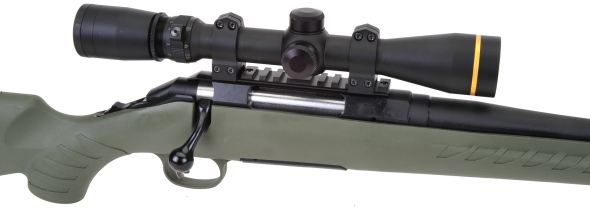
The Creedmoor cartridges, 6mm and 6.5mm versions, are typically framed in description as excellent designs for long range competitive shooting. It is fun to punch holes in paper over short and long distances, even if just at a local range and not within the confines of sanctioned competitive events. However, unlike the Ruger Precision 1600 yard rifle with 24″ barrel and predilection for competitive shooting, the Predator has a 22″ barrel and sporter type stock which makes it more at home in the hands of hunters… to the entertaining dismay of militant vegetarians the world over.
The Ruger Precision Rifle mostly exists on a diet of relatively heavy, very low drag match bullets, for delivery on distant targets. The Predator, more of a hunting rifle, must be effective with a wide variety of bullet weights and types, for use on targets near and far. It was with this thought in mind, and thoughts of pie… I love pie, a collection of bullets were pulled together and handload experimentation commenced. The objective was to maintain accuracy with light and heavy for bore bullets.
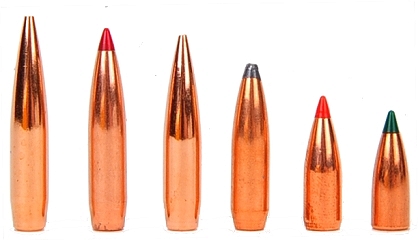
| Bullets Left to Right | Type | Nominal Weight |
Measured Length “ |
| Berger VLD Target | HP | 115 | 1.352 |
| Hornady ELD | Poly Tip | 108 | 1.225 |
| Berger VLD Hunting | HP | 105 | 1.220 |
| Speer | BTSP | 100 | 1.045 |
| Hornady V-Max | Poly Tip | 65 | 0.840 |
| Sierra BlitzKing | Poly Tip | 55 | 0.748 |
My use of 6 mm cartridges has been narrowly limited to deer size game out to 300 yards with bullet weights generally 100 grains, plus minus a few grains depending on the toughness or fragility of the bullet. While this criteria has accumulated a record of one shot kills on large whitetail and mule deer, use of the 6mm on larger game has been avoided. I have also refrained from using the 6mm for small game and varmints.
In my judgment, the 6mm is a lot of bore for prairie dogs and rabbits and light bullet, low sectional density, low ballistic coefficient bullets are poor performers over the long haul. With heavier bullets and high sectional density, retained velocity is high, as is momentum, which aids in flat shooting and substantial penetration on medium size game. That said, I’m ignoring my biases to see what the Creedmoor can do.
Lots to do, but dies are needed to do it…
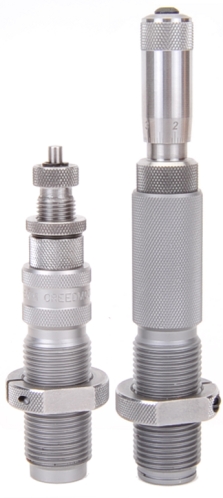 Drawing the case based on a necked down 6.5mm Creedmoor case, with 30º shoulders and 1.920″ case length yielded a model with 51.5 grains of capacity. Using another modeling tool, and factoring in more exacting dimensions including material thickness, the calculation yield was 54.1 grains. A factory Hornady round was disassembled that wet checked 52.2 grains, a once fired case wet checked 53.3 grains. The 6.5mm Creedmoor capacity is 53.5 grains. For the sake of this reloading exercise, I went with 53.3 grains gross capacity as the standard because it approximates the more careful calculation and that is the capacity of the brass I have in hand.
Drawing the case based on a necked down 6.5mm Creedmoor case, with 30º shoulders and 1.920″ case length yielded a model with 51.5 grains of capacity. Using another modeling tool, and factoring in more exacting dimensions including material thickness, the calculation yield was 54.1 grains. A factory Hornady round was disassembled that wet checked 52.2 grains, a once fired case wet checked 53.3 grains. The 6.5mm Creedmoor capacity is 53.5 grains. For the sake of this reloading exercise, I went with 53.3 grains gross capacity as the standard because it approximates the more careful calculation and that is the capacity of the brass I have in hand.
A set of Hornady Match Grade New Dimension full length sizing bushing dies were secured for this project, only because a non-bushing Hornady New Dimension die set was not available, nor were non-bushing Redding dies. Neither RCBS or Lee Precision has 6mm Creedmoor dies available.
Generally, die manufacturers have taken advantage of the Creedmoor association with competitive shooting by offering match die sets at sharply increased prices when the 6mm Creedmoor is no more exotic than a run of the mill 243 Winchester. The low end for standard 2 die rifle sets is $80 – $90. Three die match sets run $250 to $290.
By comparison, a basic dies set for the 243 Winchester is a $30 product. A 2 die micrometer seater match set is a $90 product. The low end $80 Hornady set that was used for this project is not functional until it is mated with a $23 neck sizing bushing, as the full length sizer included in the set does not size the neck without a bushing in place.
Picking and poking
I apologize for the absence of digital displays below, but they are accurate micrometers and I never have to buy batteries. The Hornady ELD bullets checked 0.243″. The wall thickness of deburred and chamfered brass measured 0.013″ which suggests a case neck with seated bullet should come in at 0.269″… but brass being what it is, and bullets being what they are, the measurement was actually a tick over 0.271″ for both factory ammo and handloads; both chambered without a problem.
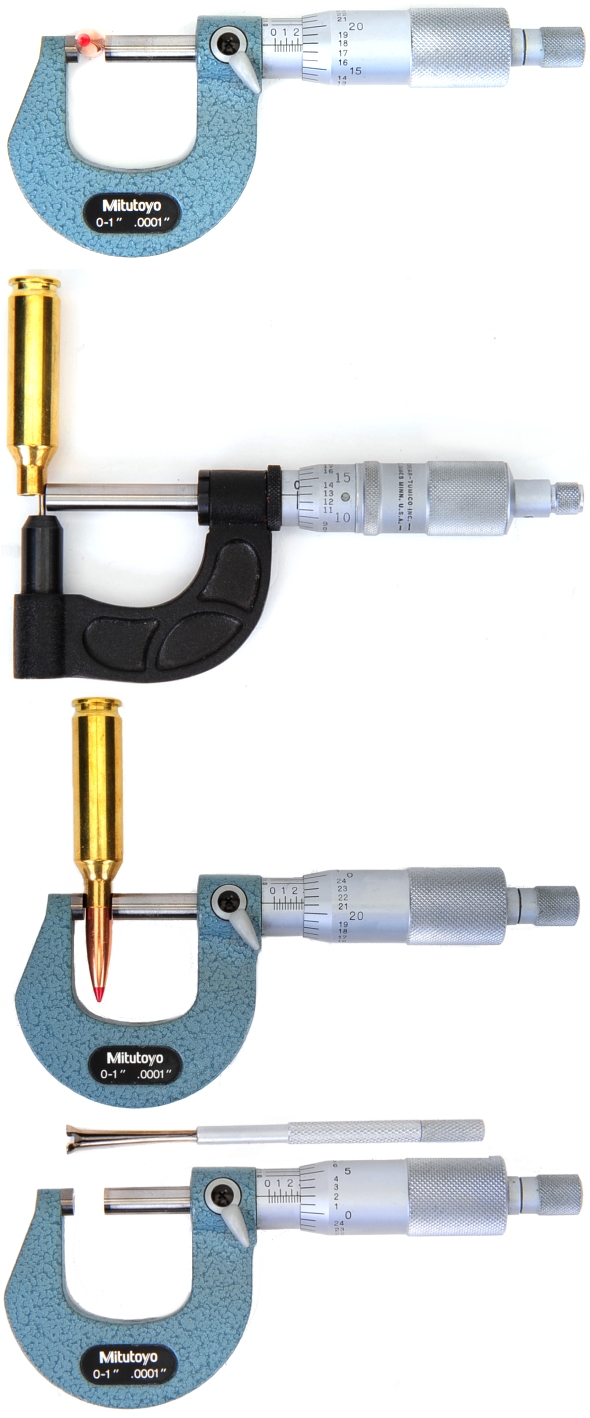
Checking the inside of the full length sizing die with a cheapo hole gauge indicated the hole within the dies where the neck passes through measured 0.278″. The drop in bushing selected was 0.268″ which places a good hold on bullets while minimizing brass distortion.
A note on twists with no appreciable turns
The Ruger American Rifle Predator has a tight 7.7″ twist, which is ideal for hefty and long match and hunting bullets, a description that represents the current 108 grain Hornady factory match loads. This particular factory ammo is rated at 2960 fps from a 24″ barrel and clocked 2850 when fired from the 22″ barrel Predator. The limited factory ammo selection led me to try a broader selection of bullet weights and types, as well as a broad selection of smokeless powder, for that matter, to see how accuracy held up across the board.
There is a variety of twist rates used in concert with 6mm cartridges. The 243 Winchester and 6mm Remington generally fall into a 9″ to 9 1/2″ depending on manufacturer. Weatherby rifles chambered for the 240 Weatherby cartridge have a relatively slow 10″ twist. Twist is not directly a determinant in bullet stability, but rather it is more of a metaphor for bullet rotation speeds which are a composite of twist rate and bullet velocity. The 240 Weatherby 100 grain bullet, with a muzzle velocity of 3200 fps and a 10″ twist, has a bullet rotational speed of 3840 revolutions per second. The 243 Winchester with 100 grain bullet and 2960 fps and a 9″ twist has a bullet rotational speed of 3946 rps. The 6mm Creedmoor with 108 grain bullet, a muzzle velocity of 2960 fps and 7.7″ twist has a bullet rotational speed of 4612 rps.
The longer and heavier a bullet the greater the rotational speed required for stability. The 6mm Creedmoor is intended to push high sectional density / low ballistic coefficient bullets a long ways down range because these types of bullets retain velocity longer, reduce time in flight so they shoot flatter and are less subject to external influences like wind and temperature. Great, so why not put a 5″ twist in every rifle and do away with low rps? Excessively fast twist rates increase bore friction and cause an increase in pressure behind the traveling bullet. Excessive rotational speeds amplify bullet design and manufacturing defects that can be as destabilizing as too slow rotational speeds. Subsequently, it is necessary to carefully select a twist rate that is consistent with a rifle’s intended bullet weight range and to use quality bullets.
On the bullet side of recommendations, the Berger VLD 115 grain bullet has a recommended 7″ twist rate, the 105 grain ELD suggests an 8″ twist.
Ya put ’em together and they look a lot like this…
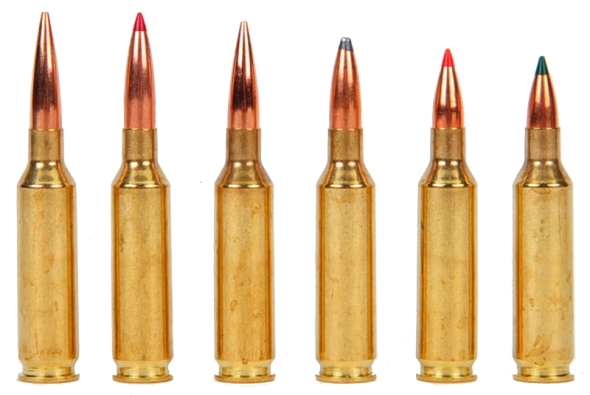
 |
Warning: Bullet selections are specific, and loads are not valid with substitutions of different bullets of the same weight. Variations in bullet material and length will alter net case capacity, pressure and velocity results. Primer selection is specific and primer types are not interchangeable. These data represents maximum loads in our firearms and test equipment and may easily be excessive in other applications. All loads should be reduced by 3%, and developed following safe handloading practices as represented in established reloading manuals produced by component manufacturers. Presentation of these loads does not constitute a solicitation for their use, nor a recommendation.
|
||||||||||||||||||||||||||||||||||||||||||||||||||||||||||||||||||||||||||||||||||||||||||||||||||||||||||||||||||||||||||||||||||||||||||||||||||||||
|
|||||||||||||||||||||||||||||||||||||||||||||||||||||||||||||||||||||||||||||||||||||||||||||||||||||||||||||||||||||||||||||||||||||||||||||||||||||||
The primary reason for this reloading exercise was to see how well the cartridge responded to various powder types and to see if the results were predictable. With the exception of one Hybrid 100V load with a 115 grain bullet, results were exceptionally predictable. I would attribute that exception to me taking a conservative approach. There were no stuck cases, flat primers or case heads tattooed by the rifle’s bolt face. I was also able to collect some preliminary shot to shot accuracy data, at least enough to know how to move forward to handload for accuracy testing… Part 3.
Shooting personality… so far
For as much as I like to shoot heavy caliber rifles that move the head and body backwards, while leaving eyeballs behind, the 6mm Creedmoor / Ruger Predator combination is truly easy shooting. That makes it a whole lot easier to concentrate on accurate shot placement without the distractions of recoil. That said, the Ruger American rifle is an incredibly accurate firearm by design and it is available in: 223 Rem, 22-250 Rem, 204 Ruger, 243 Win, 6mm Creedmoor, 6.5 Creedmoor, and 308 Win. All chambers have a 22″ barrel, with the exception of the 308 Winchester version which is 18″.
We will wrap up shortly in Part 3 with some further reloading process information and what data we have collected on shot to shot precision.


Email Notification